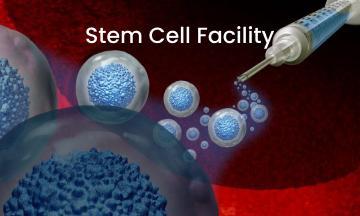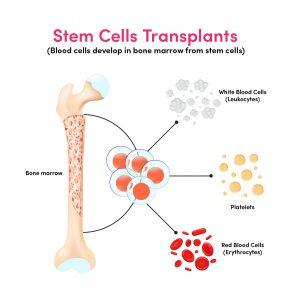Stem Cell Facility

Stem cells are precursor cells that are undifferentiated and are able to self-renew and also develop into many different cell types through differentiation. These stem cells serve as an internal repair system that generates replacements for cells that are lost through normal wear and tear, injury, or disease. These are produced from the bone marrow and enter the blood stream. They are also present in some organs and tissues and are generally associated with specific anatomical locations. These stem cells may remain quiescent (non-dividing) for long periods of time until they are activated by a normal need for more cells to maintain and repair tissues.
Stem Cell Transplant

Stem cell transplant is a procedure in which a patient receives healthy stem cells to replace their own stem cells that have been destroyed by disease or by the radiation or high doses of anticancer drugs that are given as part of the procedure.
It can be of two types – autologous and allogeneic. It is autologous when a patient’s own stem cells are collected and saved before the actual transplant and allogeneic when the stem cells from HLA matched healthy donors. The donors can be 1) syngeneic i.e from an identical twin, 2) a non-identical twin, 3) haplo identical i.e from half-matched related donors and 4) unrelated donors. The Peripheral blood stem cell transplant includes 3 main steps – 1) patient conditioning by chemotherapy/ radiation to destroy the diseased bone marrow, 2) collection and storage of peripheral blood stem cells and 3) infusion of stem cells in the patient.
Stem cell collection procedure:
Donors are selected based on the specific eligibility criteria of our BMT program. Two good peripheral veins or central line is required for an uninterrupted collection. Through one line blood from the donor flows through specific equipment designed for stem cell collection, stem cells get collected in the product bag and the rest of the blood components get returned to the donor through the other line. An appropriate dose of the stem cell product is infused to the patient as per the BMT physician’s advice.
Storage of stem cells:
Stem cell products are stored at 2-6c for planned fresh infusions and at -80c for long-term storage.
Ramaiah Stem Cell Facility, which was inaugurated last month, comprises a Collection facility and a Processing facility.
The collection facility is involved in the collection of peripheral blood stem cells, Granulocytes, and plasma exchange procedures. The processing facility is a sophisticated clean room (ISO classification – class 10,000) with a separate gowning area and designated rooms, one for minimum manipulation of the stem cells like plasma / red cell depletion, aliquotting, cryopreservation and the other for storage of stem cells. The cleanroom has HEPA filter systems to provide a controlled environment aimed at minimizing contamination/cross-contamination of the cellular products. The cleanroom has oxygen sensors and is constantly monitored for temperature and humidity at a minimum. This facility has been built with the focus on improving quality of the stem cell products in accordance with the national and international bodies.
We, at Ramaiah Blood Bank and Stem Cell Facility along with our dedicated oncologists strive to make the patient’s life better with quality stem cell products of international standards.
Assistant Professor, Department of Transfusion Medicine


